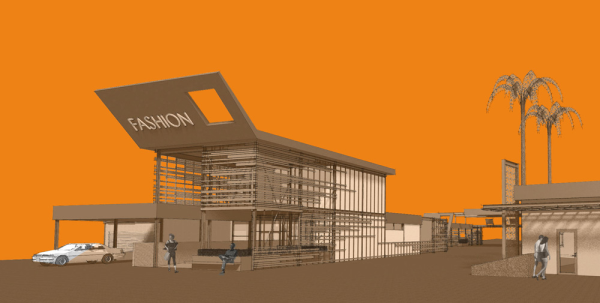Just How Commercial Architects Can Transform Your Company Area With Professional Style Solutions
Commercial architects play an important duty in reshaping organization settings. Their expertise in layout can substantially enhance both functionality and looks. By creating rooms that reflect a brand name's identity, they improve operational performance and employee complete satisfaction. The impact of their job prolongs beyond mere look. Recognizing the nuances of collaboration and sustainability can bring about transformative outcomes. What particular components make these improvements successful?
Understanding the Function of Commercial Architects
Commercial architects play a necessary duty in shaping company environments that are both practical and aesthetically pleasing. They focus on designing spaces customized to the particular needs of companies, ensuring that every square foot is made use of successfully. These professionals incorporate aspects such as spatial layout, illumination, and products to improve productivity and worker health. By working together with customers, commercial architects gather understandings into functional needs and brand identity, converting these right into cutting-edge designs.Additionally, they browse intricate building ordinance and zoning regulations, ensuring compliance while making best use of layout capacity. Their expertise reaches sustainability techniques, promoting energy effectiveness and eco pleasant materials in their tasks. Through their innovative vision and technological knowledge, commercial architects not just develop enticing rooms however likewise foster environments that promote cooperation and growth. Ultimately, their contributions significantly impact the overall success and photo of a company.
Benefits of Professional Style Providers

Tailoring Areas to Your Brand Identification
Tailoring areas to a brand name's identification is important for conveying its core values and mission. Commercial architects play a critical function in improving an organization's aesthetic identification with thoughtful style options. By lining up building elements with brand principles, business can create environments that resonate with customers and employees alike.
Reflecting Brand Worths
Just how can a properly designed area embody a firm's core values? Commercial architects play a vital function in shaping settings that reverberate with a brand's identity. By integrating components such as shade systems, materials, and formats, they create areas that mirror the significance of business. A tech firm may decide for open designs and modern home furnishings to convey development and collaboration, while a high-end brand might select classy surfaces and intimate rooms to stimulate exclusivity and class. Thoughtful layout not only boosts performance but likewise cultivates a solid link between workers, customers, and the brand name. Ultimately, a well-crafted atmosphere acts as a substantial representation of a business's goal and vision, reinforcing its values at every touchpoint.
Enhancing Visual Identity
What aspects can effectively raise a brand name's aesthetic identity within a commercial area? Commercial architects play an essential duty in incorporating design functions that resonate with a firm's principles. Color pattern, typography, and materials can be tactically selected to mirror brand values while making sure visual allure. Additionally, including logos and brand images right into the style can develop a cohesive aesthetic story. Lighting design can additionally improve the atmosphere, directing client understandings and experiences (commercial architects). Design and furniture options ought to straighten with the brand name's character, whether it's contemporary, standard, or cutting-edge. Inevitably, a properly designed business room not just brings in consumers yet likewise enhances brand acknowledgment, developing a lasting impact that cultivates commitment and interaction
Enhancing Performance and Effectiveness
Enhancing functionality and efficiency in commercial rooms involves optimizing room application and making operations that enhance operations. Architects concentrate on developing designs that reduce wasted space while facilitating smooth adjustments between jobs. This method not just enhances productivity yet also adds to a much more cohesive functioning atmosphere.
Optimizing Area Utilization
Reliable space use is a critical consider business design, where the style must stabilize appearances with capability (commercial architects). Architects employ numerous Visit Your URL techniques to take full advantage of offered square footage while guaranteeing that each area offers a distinct function. By analyzing process, traffic patterns, and individual requirements, architects can produce formats that enhance both worker performance and customer experience. Multi-functional spaces, versatile furnishings plans, and maximized storage services are important elements in attaining this objective. In addition, incorporating natural light and open rooms fosters a more inviting ambience, further elevating the utility of the atmosphere. Eventually, reliable room utilization not only improves operational effectiveness however additionally contributes favorably to the overall brand picture, making it a vital factor to consider in commercial design
Streamlined Process Style
Just how can a well-designed workflow transform an industrial area right into a hub of efficiency? Streamlined process style concentrates on optimizing the physical format and functional processes within a service setting. By purposefully arranging workstations, meeting areas, and sources, architects can remove unneeded activity and enhance collaboration. This thoughtful design decreases interruptions and assists in interaction, enabling workers to concentrate on their jobs a lot more effectively. In enhancement, integrating technology into the operations can better automate processes, reducing time invested in regular jobs. Therefore, companies experience improved staff member spirits and enhanced output, producing a dynamic environment that cultivates advancement. Eventually, spending in structured workflow layout not just improves functionality yet likewise places an industrial room for lasting growth and success.
Promoting Collaboration Via Style
Modern offices frequently prioritize specific performance, the layout of industrial spaces significantly emphasizes collaboration as a crucial driver of technology helpful site and group communication. Architects play a crucial duty in producing settings that foster interaction amongst workers. Open up layouts, multifunctional rooms, and strategically put public areas motivate spontaneous conversations and conceptualizing sessions.Incorporating elements such as movable furniture and versatile conference room permits teams to reconfigure spaces based on their collective demands. Furthermore, incorporating technology, like interactive whiteboards and video conferencing tools, improves the capability to interact properly, no matter location.Natural light and biophilic style components also add to a more inviting environment, advertising convenience and health, which are crucial for productive synergy. By concentrating on these facets, business architects can develop vibrant settings that not only improve collaboration but likewise drive general service success.
Sustainable Style Practices in Commercial Design

Situation Studies: Effective Makeovers by Commercial Architects
The implementation of sustainable design practices has not only reshaped the technique to industrial style yet has actually additionally led to remarkable transformations in various company rooms. One remarkable instance is the redesign of a technology firm's head office, where architects incorporated natural light and environment-friendly wall surfaces, causing boosted staff member wellness and efficiency. This improvement reduced power costs by 30% and boosted the business's public image.In one more circumstances, a store went through a complete overhaul, utilizing reclaimed products and energy-efficient systems. This not only brought in eco-conscious customers but also increased foot website traffic by 25%. A 3rd situation involved a company office that embraced an open-plan layout with flexible offices, promoting partnership amongst groups. The architects' concentrate on creating a vibrant and versatile atmosphere considerably enhanced employee satisfaction. These study exemplify just how industrial architects can create impactful areas that align with organization goals and sustainability efforts.
Frequently Asked Inquiries
Just How Much Do Commercial Architecture Solutions Usually Cost?
The expense of commercial design services varies commonly, commonly ranging from $100 to $250 per hour. Elements affecting rates include job intricacy, area, and the designer's experience, making it important for organizations to obtain thorough estimates.
What Kinds of Organizations Benefit The Majority Of From Commercial Architects?
Various services, consisting of retail, hospitality, and corporate workplaces, considerably advantage from commercial architects. These professionals improve functionality, aesthetics, and brand identification, making certain rooms are enhanced for consumer involvement and employee efficiency, eventually promoting organization growth.
Exactly how Long Does a Commercial Style Job Usually Take?
The timeline for a commercial design task usually varies from numerous weeks to numerous months. Factors affecting duration consist of project complexity, regulative authorizations, and cooperation amongst stakeholders, every one of which can influence total conclusion time.
Can I Work With a Business Architect for Restorations Just?
Yes, employing an industrial designer for restorations is practical. Lots of architects concentrate on improvement jobs, supplying proficiency in optimizing existing spaces while adhering to laws and boosting performance, appearances, and total worth of the service setting.
What Certifications Should I Seek in an Industrial Designer?

Comments on “The Impact of commercial architects on City Skylines and Urban Identity”